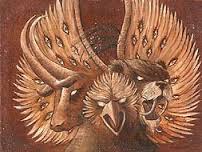In our exploration of the various choirs of angels, we have now made our way to the second choir, the Cherubim.
Before we get started, however, it is important that we take the time to talk about what is (and what is not) a cherub. These are not cherubs.
Strictly speaking, chubby baby angels aren’t angels at all, let alone representative of the choir of Cherubim. These are putti, which originated as the winged spirit-babies in pagan fertility art and were co-opted by Baroque painters to represent angels. The god Cupid is a prime example of these little fellows, though he is not — strictly speaking — always represented as one. They are usually his messengers.
True cherubs, on the other hand are not cuddly or baby-like in any way. Nope. They’re incredibly fierce, guardians of sacred spaces (most notably protectors of the Throne of God).
They are represented in symbology as having four heads, one of an ox, one of a lion, one of an eagle, and one of a man. Unlike the six-winged Seraphim, they have four wings, and use one set as a covering and the other for flight.
Many angelologists say that the use of these four faces is symbolic of the four chief qualities the Cherubim express. The ox represents Fortitude, the lion Strength, the eagle Swiftness, and the man Intelligence. These symbols were later used for the four gospel writers, so perhaps there is something to that.
Perhaps the most disturbing detail of cherub appearance is that each of their wings is said to be covered in eyes. Symbolically, this represents their ability to see threats to their charges from any direction, but it does make for a pretty scary visual. (Still, at least they’re more humanoid in description than the Thrones…)
The word “cherub” comes to us from Assyrian through Hebrew, and roughly translates as “to be near,” which alludes to their role as protectors and direct servants of God. (Note that it is close in sound to the Hebrew khereb, meaning “sword,” but these are not related terms.) It is thus believed by comparative mythologists that they are related to the shedu, winged bull-men who guard Assyrian temples.
The main purpose of Cherubim are as protectors of sacred objects and forbidden places. In many traditions, it was a cherub who was sent to guard the entrance of the Garden of Eden with a flaming sword (which leads some to assume that Uriel operates in more than one choir). Golden Cherubim were placed on the legendary Ark of the Covenant, and any man that touched it would die instantly. These two examples alone should be enough to foster respect for these mighty spirits, but their rather frequent appearance in both testaments mean that their significance cannot be belittled by a Christian Angelologist.
May we all grow ever closer to God and unite our voices to those of the Cherubim in singing his praises.
-E. G. Norton




